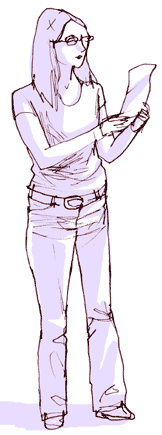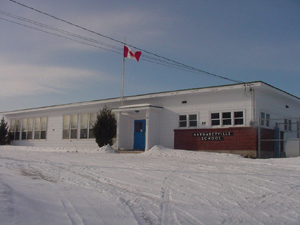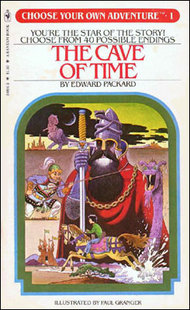
J. R. Carpenter
drawn by Sherwin Tjia
Blue Metropolis Teleliterature Program Workshop
My name is J. R. Carpenter. This is my website: http://luckysoap.com. If you've already looked my website together in class then you already know one of my favourite things about electronic literature - it's so accessible! I am in Montreal and you are in your classroom and we are looking at the same web page. For the past twelve years I've been using the internet to share stories about places that are important to me with people all over the world.Today I'm going to show you some of my electronic literature projects. If I go too fast or if the technology goes too slow, you can come back and view this archive of today's presentation.
Let me begin by telling you a few things about me. I grew up on a farm in rural Nova Scotia. I went to a very small school. The Internet didn't exist yet, but I could travel the world through books. I have always loved reading and telling stories. You can find a list of books I'm reading right now by visiting my blog: http://luckysoap.com/lapsuslinguae

In addition to writing electronic literature, I also write poetry, short stories and essays about art and technology to published the traditional way, in books and magazines. You can read some of these published works online here: http://luckysoap.com/publications.html
There are many online journals that publish on the web because it's more economical and more accessible to readers. Publishing poetry and short stories online is a great way to gain exposure and reading poetry and short stories online is a free and easy way to see what other writers are doing all over the world. Two examples of online journals:
Electronic literature is not a replacement for print publishing, and just because a story is published online doesn't mean it is electronic literature. Electronic literature combines aspects of literature (such as narrative) with computer functions (such as hypertext links or Flash animation. You can learn more about electronic literature by visiting the website of the Electronic Literature Organization.
But don't be distracted by the technology. The important thing is the story. I always begin by writing a story. Some stories just can't be published in a book.
Let me show you some examples of what I mean by this from my work: http://luckysoap.com/webprojects.html
When I made my first electronic literature projects the web was very new. The technology was quite limited. That made it very easy to learn! I do all of the visual art work and the computer programming for these projects myself. And if I can do it, you can do it. Here's a tip: if you see a web page you like, click on "view" in the browser navigation bar and select "view page source" - see if you can recognize any of the page elements.
Fishes & Flying Things is the first web project I made. [click on the fish] I was trying to tell a circular story in book form and it just didn't work because when people got to the end of the book they stopped reading because that's what you're supposed to do with a book. But then I realized that if I translated this story into HTML I could link the last page to the first page and the reader would keep going around and around. You will notice that all my early works are in black and white - it's because before computers I used photocopiers to combine images and texts - all the images I had on hand were in black and white.

Mythologies of Landforms & Little Girls is an example of a non-linear narrative. When I sat down to write this story it didn't seem to have a beginning or and end. The point of the story was that all the ideas in it came together in the narrator's mind at one time. I used a lot of geological metaphors to make the story sound like it happened a really really really long time ago. An early example of a non-linear narrative is the "choose your own adventure" genre of books that were popular when I was a kid. The reader can read in read the story in a number of different ways and every reader's experience will be different depending on how and how much they read. I contrasted the simple first-person narrative with quotations from civil engineering manuals - creating a tension between two very different texts like this is called intertextuallity.
How I Loved the Broken Things of Rome is an example of intertextuality. I often combine my own writing with quotations from other authors. I lived in Rome briefly in 2002. For thousands of years travelers have tried to write about their experience of Rome. My experience there reminded me very much of when I first moved to Montreal and didn't speak any French. In many ways, How I Loved the Broken Things of Rome is about language and the struggle to communicate. Each window is like a postcard.
Entre Ville is the first big piece I made about Montreal. After many years of writing about far away places, I finally figured out how to write about where I live. Entre Ville is about my back alleyway. The poem was published first. Then I shot the video. Then I got a commission to make a piece for the 50th anniversary of the Montreal Arts Council. Perfect timing! There are many different ways to read this piece. You can read the whole poem using the red arrows to scroll. And then you can click on window and doors to see sections of the poem reappear in more detail.
Les huit quartiers du sommeil is also set in Montreal. In this case, I was invited to write a text for an anthology on the theme of sleep. I've lived in eight different neighbourhoods in Montreal, so I wrote a short story about the quality of sleep in each one. Then friend started telling me about Google Maps and I had the idea to make the piece this way. The text has since been translated into French and will be published in the spring. Maybe then I will add the French to the web version. Versatility of the medium.
There are an infinite number of possibilities for you to experiment with to create electronic literature projects of your own. I'm going to show you just one: how to enter your own stories into Google Maps: http://maps.google.ca/maps
Enter the address of your Postcaard Story. Save to My Maps. You must sign up for a free Google Account to log in. Within "My Maps," you can create maps with multiple locations, enter your own texts and pictures and select icons for each location - this is how I made Les huit quartiers du sommeil.
Further Readings: Electronic Literature Collection Volume One
For more links and reading lists, visit:
lapsus linguae (a blog of sorts)
 J. R. Carpenter || bio || electronic literature || publications || talks || blog
J. R. Carpenter || bio || electronic literature || publications || talks || blog